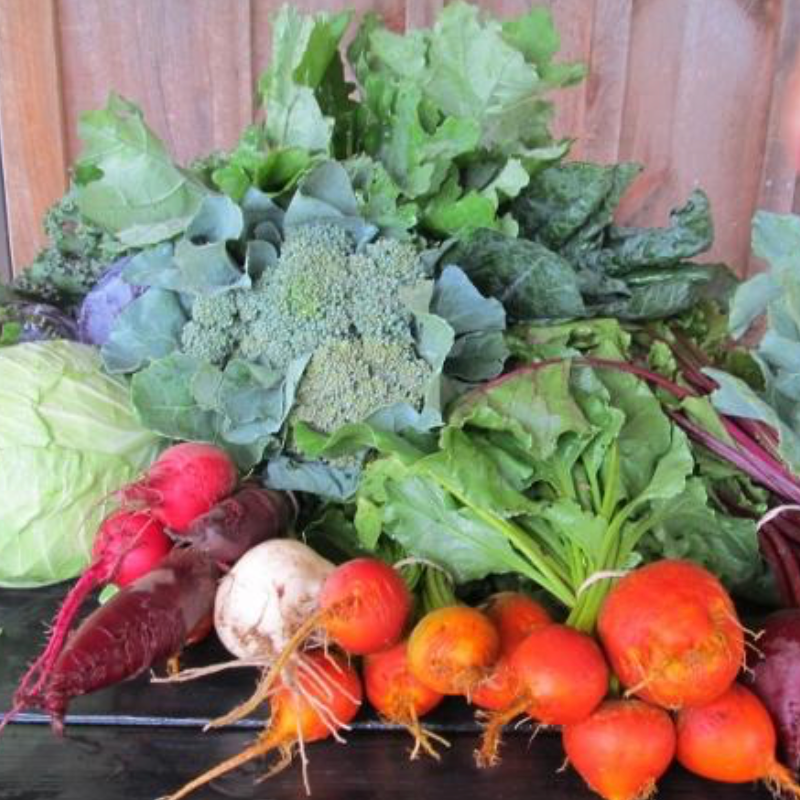
Are we there yet? Knowing when to harvest your veggies
Getting the most out of your garden harvest doesn’t always mean picking the biggest veggies. Although here in the Northeast we wait and wait most of the year for the ephemeral tender crops of summer, many home gardeners can wait too long and miss the window of tastiness. As with the growing window, there’s an optimal harvest period too. The best way to catch the sweet spot is to mark the number of days to harvest (on your seed pack) on your calendar based on when you planted the seeds. Start checking a week or so before that date as it can vary depending on your micro-climate and the peculiarities of that season's weather. Some crops are forgiving and flexible: giving us a leisurely long harvest window; others should be picked right away, lest they turn bitter and woody on us. Below are some crops that have been ripening on our farm (and a few others we look forward to picking in the next months). Read the harvest tips to guide you to the most delicious summer and autumn-fresh meals:
Roots:
Beets can be harvested at whatever size you prefer best, but when they are about an inch in diameter, the greens are at their prime for picking. If you planted them with thinning in mind, pick the thinnings then to get two veggies out of one plant. For fall plantings, pull beets before first frost.
Carrots are sweet and juicy when they are less than 2 inches in diameter. Usually, when the tops are that width, they are at a desirable length too, but pull one first to be sure. After a light frost, carrots become even sweeter and they can be kept in the ground even once they mature – for winter harvests (just be sure to mulch them well if keeping till winter).
Radishes should be picked as soon as the top of the bulb pops out of the ground, otherwise they will quickly turn woody and start going to seed.
Rutabagas are generally ready about 3 months after planting. They get sweeter with cold weather and can be left in the soil and harvested at any time through the winter.
Brassicas:
Broccoli values good timing. Since the choice edible are the unopened flower buds, check often especially in hot weather. Harvest when the buds are tight, not after they open and get ready to flower.
Brussels Sprouts will mature at different times on one stalk, usually from the bottom up. Start picking them off when they are about an inch in diameter.
Cabbage heads feel solid and tight to the touch when they are ready for harvest. Wait too long and they will split open!
Cauliflower grown at home will likely be smaller than ones in a supermarket. Pick them while the florets are still tight and the surface smooth.
Leaves:
Head lettuce is ready when the head feels firm and well rounded and before a central stalk is formed. The stalk means the lettuce is ready to bolt.
Leaf lettuces taste great at 4 inch height. Keep the inner leaves for continual harvests.
Kale can be harvested any time, any leaf size, any part of the season. The trick is to pick leaves from the bottom and leave a few at the top for the plant to keep producing. Kale plants grow like a palm tree and the same plant can last through the growing season.
Chard can be harvested just like kale. It too grows like a palm tree.
Cucurbits:
Melons have a spot where the fruit is in contact with the ground. It should turn a whitish color and be slightly softer than the rest of the skin.
Cucumber should be harvested young for prime juiciness and flavor. The size will vary with each variety, but look for fruits that are firm, smooth, and not extra large. Taste test a couple to see what stage you like best and then continue harvesting at that size.
Summer Squash follows the exact same procedures as do cucumbers. Be sure the skin is soft enough for to poke a fingernail through.
Winter Squash doesn’t tolerate frost and signals readiness when it matures to the color that its particular variety is supposed to be.
Nightshades:
Tomatoes should reach their final color and be slightly soft to the touch. They should also come of the plant easily with a twist of the stem.
Peppers, hot and sweet, start out green and develop color later. For the sweet ones, wait until they are full size at least and wait for color do develop if you’d like. The hot ones are hotter when green, better for drying and storage when left on the plant to develop color and harvested later in the season.
Eggplants are most delectable when slightly immature. Look for shiny, firm fruit and cut it off the plant, rather than pulling off and risking damage to the stem or roots.
And:
Corn silks will turn brown and dry up about three weeks after they are formed. That’s a good sign that the cobs are ready to be picked!
Snap Beans are best when the pod is bulging and full, but wait any longer and they’ll turn woody.
Do you have harvesting questions? Post them in the comments and we’ve get back with an answer.







